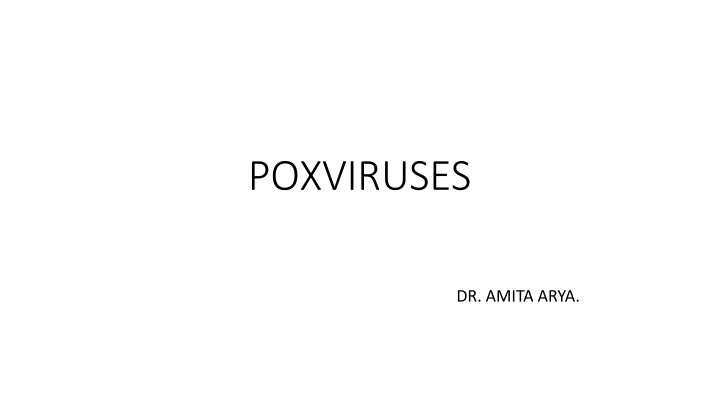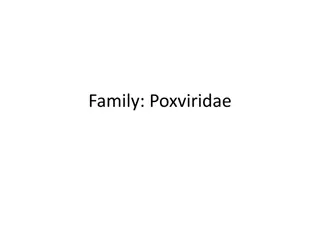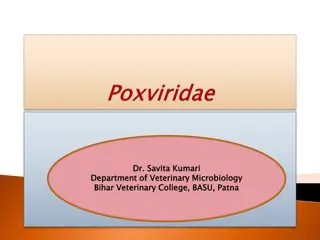
Exploring Poxviruses - Family Poxviridae and Variola Virus Overview
Discover the world of poxviruses with insights into the Poxviridae family, Chordopoxvirinae subfamily, and uncategorized viruses like Molluscum Contagiosum virus. Learn about the structure, properties, cultivation, and antigenic features of these viruses, including a focus on Variola virus and its role in the eradication of smallpox. Explore the diverse host range and characteristics of poxviruses in this comprehensive overview.
Download Presentation

Please find below an Image/Link to download the presentation.
The content on the website is provided AS IS for your information and personal use only. It may not be sold, licensed, or shared on other websites without obtaining consent from the author. If you encounter any issues during the download, it is possible that the publisher has removed the file from their server.
You are allowed to download the files provided on this website for personal or commercial use, subject to the condition that they are used lawfully. All files are the property of their respective owners.
The content on the website is provided AS IS for your information and personal use only. It may not be sold, licensed, or shared on other websites without obtaining consent from the author.
E N D
Presentation Transcript
POXVIRUSES DR. AMITA ARYA.
INTRODUCTION Family Poxviridae Subfamily Chordopoxvirinae - Entomopoxvirinae
CHORDOPOXVIRINAE Orthopox virus Variola, Vaccinia - Cowpox, Monkeypox, Rabbitpox, Buffalopox - Camelpox, Mousepox Parapoxvirus Capripox virus Sheep pox, Goat pox (Lumpy Skin disease) Leporipox virus Myxoma & Fibroma (rabbits, hares, squirerels) Avipox virus Suipox virus - Swinepox - orf, Paravaccinia (Ungulates) - Fowl pox, Turkey pox, Pigeon pox, Canarypox virus
UNCLASSIFIED VIRUSES Molluscum Contagiosum virus Tanapox Yaba pox virus
VARIOLA VIRUS Small Pox Global eradication of Smallpox 8th May1980 Variola major Classical smallpox Variola minor Alastrim
Vaccinia virus Smallpox virus Artificial virus Vector for the development of recombinant vaccines Genome can accommodate 25,000 base pairs Not a suitable vector for humans
MORPHOLOGY Brick shaped
PHYSICAL AND CHEMICAL PROPERTIES Viable for months at room temperature Susceptible UV light, Formalin - 50 % Glycerol, 1% Phenol, Ether Resistant Enzymes ++ Multiplication - Cytoplasm
ANTIGENIC STRUCTURE Immunodiffusion 20 antigens Nucleoprotein antigen LS antigen Agglutinogen Hemagglutinin
CULTIVATION AND HOST RANGE Chick Embryo Tissue culture Animals
CHICK EMBRYO Vaccinia Pocks Variola Pocks
CEILINGTEMPERATURE Vaccinia 41 C Variola major 38 C Variola minor 37.5 C
TISSUE CULTURE Monkey kidney, HeLa & Chick embryo cell lines Vaccinia Cytopathic effects (24 48 hours) - Plaque (Chick embryo) Guarnieri bodies eosinophilic inclusion bodies
ANIMAL INOCULATION Vaccinia virus Monkeys, Calves, Sheep & Rabbits Variola virus Keratitis - Guarnieri bodies
SMALL POX No reservoir & carrier stage Source Patients Route of spread Inhalation Incubation period 12 days Enanthems Buccal mucosa Exanthems Skin lesions (Haemorrhagic, Flat, Ordinary or Modified) Macule Papule Vesicle Pustule - Scabbing
HaemorrhagicExanthem FlatExanthem
OrdinaryExanthem ModifiedExanthem
LABORATORYDIAGNOSIS Sample Fluid from eruptive lesions - Blood Antigen detection, Isolation of virus Electron Microscopy Paschen bodies
Milkers Node Paravaccinia virus Lesions small ulcerating nodules Chick embryo No growth Bovine kidney cultures Resembles orf virus morphologically
Orf virus Sheep & Goats Contagious Pustular Dermatitis Single papulovesicular lesion with a central ulcer Hands, forearm or face Unrelated to Variola vaccinia group
MOLLUSCUMCONTAGIOSUM Sexually transmitted disease Pink or pearly white wart like nodules on the skin Molluscum bodies large eosinophilic hyaline inclusion bodies Virus cannot be grown in eggs, tissue culture or animals
THANK U THANKU


